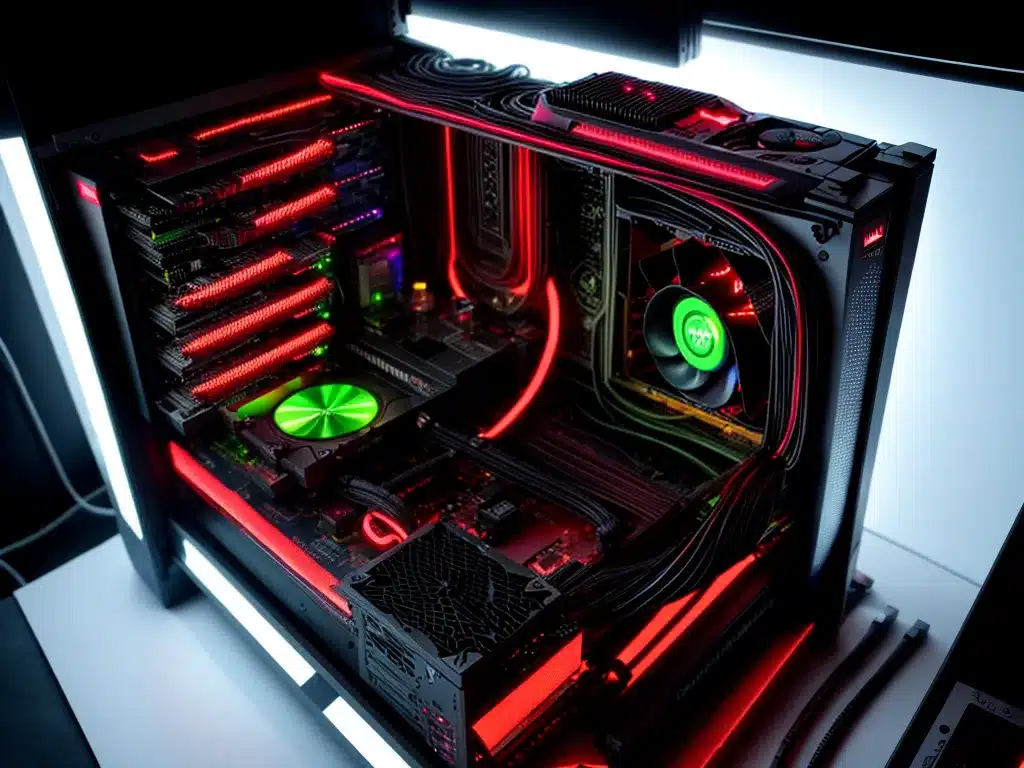
A graphics processing unit (GPU) bottleneck is when your graphics card limits the performance of your gaming PC. This commonly happens when you pair a powerful CPU with a weaker GPU. The GPU can’t keep up with the CPU, creating a bottleneck. Here’s how to diagnose and fix GPU bottlenecks for improved gaming performance.
Symptoms Of A GPU Bottleneck
How do you know if your gaming PC has a GPU bottleneck? There are a few key symptoms to watch out for:
Low Frame Rates
The most obvious sign is low and inconsistent frame rates in games, even on lower settings. This happens because the GPU can’t render frames fast enough to keep up with the CPU and display.
High CPU Usage, Low GPU Usage
Check your hardware monitor software (like MSI Afterburner) while gaming. A GPU bottleneck will cause high CPU usage (80-100%) and low GPU usage (50% or less). The GPU isn’t being fully utilized because it can’t keep up.
Upgrading CPU Doesn’t Improve Performance
If upgrading your CPU doesn’t improve game performance, it’s likely because the GPU is still the bottleneck. The faster CPU can’t help since the GPU is already maxed out.
Game Stuttering
Stuttering, freezing, or choppy gameplay can indicate a GPU bottleneck too. The GPU is overwhelmed and starts dropping frames, causing the game to stall momentarily as it tries to catch up.
Diagnosing A GPU Bottleneck
If you suspect a GPU bottleneck, here are some tips to diagnose and confirm it:
Monitor CPU and GPU Usage
Use hardware monitoring to view CPU and GPU usages while gaming. A maxed out CPU with low GPU usage points to a bottleneck.
Lower Graphics Settings
Drop your game settings to low/minimum and check if performance improves significantly. If so, the GPU was the limiting factor at higher settings.
Check GPU Clock Speeds
A GPU running below its max rated clock speeds indicates a bottleneck. It can’t reach full utilization and downclocks as a result.
Benchmarking
Run gaming benchmarks and compare results to other systems with the same GPU. Much lower scores indicate your GPU is being held back.
Upgrade GPU and Retest
Ultimately, swapping in a faster GPU and retesting performance is the best way to confirm a bottleneck. Look for FPS gains far above the increase in GPU power alone.
Fixing A GPU Bottleneck
Once diagnosed, here are some tips to resolve a GPU bottleneck:
Upgrade Your Graphics Card
The most direct solution is upgrading to a faster GPU that better matches your CPU. Seek at least a 30-50%+ increase in benchmarks for meaningful gains.
Overclock Your GPU
If upgrading isn’t an option, overclocking your existing GPU can help narrow the gap until you can upgrade. Just don’t overdo it.
Enable VSync
Enabling VSync locks your frame rate to your monitor’s refresh rate, like 60hz or 144hz. This can “hide” a GPU bottleneck and stabilize performance.
Lower Graphics Settings
Dropping graphics settings reduces workload on the GPU. You can target higher, more consistent frame rates this way.
Close Background Apps
Closing unused apps reduces system resource usage, freeing up more for the game and GPU. Disable background processes too.
Add More GPU Cooling
Better GPU cooling allows higher sustained clock speeds before thermal throttling occurs, improving performance.
Tune Game Settings
Some games have settings that are more CPU or GPU bound. Adjust these to shift load away from the GPU.
Upgrade Monitor
If you have a high refresh rate gaming monitor, consider dropping to 60hz. This requires far less GPU power so the bottleneck isn’t exposed.
Upgrade Rest of System
Other components like RAM, storage, and your PSU all impact gaming performance. Upgrading these may help relieve a GPU bottleneck.
Bottom Line
A GPU bottleneck is a common gaming PC issue, but diagnosing it properly and applying fixes can get you back to smooth gameplay. Matching your CPU and GPU power is key, so consider upgrading if needed. Take a balanced approach to your gaming PC builds and you can avoid bottlenecks.












